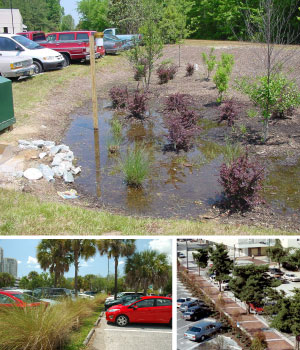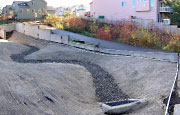 |
||||||||

 Wanted: Recipes for Elephant!
Wanted: Recipes for Elephant!
By Suzanne Cooper

Photos courtesy Alabama Cooperative Extension Service
and Ekistics Design Studio
Low-impact development calls for as much rain to be retained on site as possible, minimizing contamination caused by stormwater. Left, a rain garden in Alabama, center and bottom, the Florida Aquarium parking lot in downtown Tampa.
You’ve heard the quip about tackling insurmountable tasks: “How do you eat an elephant? One bite at a time!”
That’s the idea behind nitrogen management in the Tampa Bay watershed. Most people — even our local leaders – don’t necessarily find it to be a particularly interesting topic, but controlling nitrogen loading is crucial to the region’s environmental and economic health. Each small bite we take of this “elephant” will result in a healthier and more productive Tampa Bay.
State and federal agencies have determined that Tampa Bay has too much nitrogen pouring into it — primarily from the land, in stormwater runoff containing fertilizer from yards and agriculture, pet waste, auto emissions, and so on. They have mandated that nitrogen loadings be kept at current levels. That wouldn’t be too hard if the region wasn’t expecting to approve any new construction or redevelopment, any new industry, or any new roads. In other words, we’d be okay as long as everybody has the job they want and nobody else ever wants to move to Tampa Bay.
The science can get complicated, but all plant life, including algae, requires equal amounts of nitrogen and phosphorus. Nitrogen is our limiting nutrient because phosphorus is so naturally abundant in the Tampa Bay region that it would be impossible to control it enough to make a difference. (This is not the case in other parts of the country — or even the state — where phosphate does not occur naturally in such high levels.)
So the “elephant we’re eating” is controlling the amount of nitrogen released into our water and air, thus limiting the growth of organisms that use up the oxygen in our bay waters, preventing seagrasses from growing and causing fish kills. And if we could actually reduce the amount of nitrogen that is released to below the current level, we have “room” in the calculations for growth, redevelopment, new homes, new industry and new jobs.
Do you see the elephant yet?

Photo courtesy University of Florida
A bioswale under construction in Gainesville is designed to take advantage of a naturally hilly site.
The first chewy bites of this elephant have been taken over the past decade or so. An award-winning framework for reducing nitrogen loading, called the Nitrogen Management Consortium, was created after the Tampa Bay Estuary Program identified excess nitrogen as the chief reason that seagrasses were declining in the bay. This is a collaboration of the region’s local governments and private entities. Most of the participants have reduced emissions or discharges into the bay or its tributaries, or implemented stormwater improvement projects. More than 400 tons per year have been removed from the bay since 1995 — resulting in dramatic improvements to bay waters and air quality.
Some more bites were taken earlier this year. The Nitrogen Management Consortium is comprised primarily of stormwater and wastewater managers from local governments and industry — people who control tons of nitrogen or spend their days focused on preventing pollution. They’ve made amazing strides, but they’ve pretty much reached their limit, at least from an economically feasible perspective. (It’s possible but much more expensive to clean up nitrogen once it’s been released. See Bay Soundings, Spring 2011 for more information.)
Now we need to reach past the stormwater managers and point sources to get local government planning staffs and policy makers up to speed on the state and federal mandates. Although controlling nitrogen might not be their primary job, growth may come to a screeching halt if they don’t help “eat this elephant.”
Over the past 20 years or so, many cost-effective and attractive techniques have been developed to reduce nitrogen loadings in stormwater runoff — now the primary source of contaminants that reach Tampa Bay. These technologies can be used in either new development or redevelopment projects — but they’re usually not recognized, and may actually be prohibited in local building codes.
Across the country, a tremendous reduction in nitrogen has been documented with techniques like pervious pavement, rain gardens, roadside swales and curb-less parking lots. At two workshops earlier this year we opened discussions about incorporating these types of alternative building standards into various local building codes. It has been a learning process, and led us to think about how best to present the concepts in the future.
That’s where the recipes for elephant come in!
Each local government has a vision of itself, sometimes right down to a formula for requiring a set number of parking spaces — and it’s not always easy to modify that vision. Land developers and their consultants aren’t likely to try to incorporate runoff-reducing methods unless they are sure that the permitting entities have embraced them already; otherwise they could end up wasting enormous amounts of time and money.
So to break the log jam we’ll be feeding the elephant to these two groups in bite-size pieces, along with side dishes (reports) on how important limiting nitrogen is to the health of Tampa Bay, what it means for future growth (or not!) in local municipalities, how nitrogen-limiting strategies have worked in other places, and the cost of compliance (or non-compliance) for governments, developers, and the general citizenry. But those bites must be “palatable” in terms of public acceptance, budgetary feasibility and fairness of implementation.
We think this effort will result in more sustainable neighborhoods, lower costs to local governments, continued growth and redevelopment of our region, and improved water quality and habitat in the Tampa Bay ecosystem.
And the elephant will be gone before we know it!
Suzanne Cooper, AICP, is a principal planner for the Tampa Bay Regional Planning Council and staff to its Agency on Bay Management.
